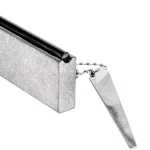As we build our homes closer to the wild, encounters with animals like deer and bears are becoming more common. Defenders of Wildlife work tirelessly to foster harmony between these wild neighbors and humans.
This article will share essential tips on living safely alongside wildlife, protecting both us and them. Stay tuned for lifesaving advice!
Table of Contents
- Understanding the Concept of Coexisting with Wildlife
- Guidelines for Safe Human-Wildlife Coexistence
- Impact of Human-Wildlife Conflicts
- Strategies for Protecting Wildlife
- Role of Community in Promoting Wildlife Safety
- Conclusion
- How Can Understanding the Science Behind Survival Gear Help with Wildlife Awareness and Coexisting Safely with Nature?
- FAQ
Key Takeaways
- Maintain a safe distance and never feed wild animals to prevent altering their natural behaviors and safeguard both our safety and theirs.
- Dispose of trash properly with secure lids or animal-proof containers, clean cooking areas, and participate in community clean-ups to minimize wildlife attraction and potential conflicts.
- Support habitat conservation efforts through sustainable land use practices such as protective zoning regulations, non-lethal livestock protection methods like guardian dogs, and promoting eco-friendly tourism.
- Engage in public education campaigns to raise awareness about coexistence strategies and proper trash disposal, highlighting the importance of not engaging in harmful activities like poaching.
- Contribute to habitat restoration by planting native vegetation, removing invasive species, creating wildlife corridors for safe movement, and using non-invasive monitoring tools like trail cameras.
Understanding the Concept of Coexisting with Wildlife
Living alongside wildlife means accepting these creatures as neighbors and recognizing their right to exist in their natural habitats. It requires adapting our behaviors so that wild animals can thrive without coming into harmful contact with people, crops, or livestock.
Coexistence is built on respect for the diversity of life and understanding the interdependency between humans and nature. This practice is vital for maintaining ecological balance and ensuring the survival of both endangered species and entire ecosystems.
Coexisting isn’t just about avoiding conflict; it’s about creating environments where human-wildlife interactions are positive or neutral rather than destructive. For example, wildlife crossings help mitigate habitat fragmentation by allowing safe passage over busy roads, thereby reducing animal deaths and vehicle collisions.
Communities around the globe are engaging in practices that protect biodiversity while respecting cultural values—a movement supported by international organizations such as the Convention on Biological Diversity.
Moving forward into the next section, we will explore specific guidelines for fostering this delicate balance between humans and wildlife in daily life.
Guidelines for Safe Human-Wildlife Coexistence
Living harmoniously with our wild neighbors requires respect for their space and behaviors; this delicate balance is achieved through key guidelines that ensure the safety of both humans and animals.
These rules are not just suggestions but essential tools for fostering a peaceful coexistence where the well-being of wildlife is regarded as highly as our own.
Maintaining a Safe Distance from Wildlife
Respecting the space of wild animals is crucial for our safety and their survival. Observing creatures from a distance allows them to behave naturally and prevents dangerous encounters. Here are guidelines to maintain that crucial separation:
- Educate yourself about local wildlife: Before venturing into wilderness areas, learn about the species you might encounter. This knowledge can help you estimate safe viewing distances.
- Use binoculars or telephoto lenses: They offer a close-up view without getting physically close to the animals. This helps minimize stress on wildlife and keeps you safe.
- Stay on marked trails: Trails are designed to protect both visitors and habitats. Wandering off may lead to unexpected wildlife encounters.
- Keep your campsite clean: Always store food in animal-proof containers far from your sleeping area. Cleanliness reduces the risk of attracting curious or hungry animals.
- Avoid mothers with young: Female animals with offspring are especially protective and can be unpredictable if they feel threatened by your presence.
- Heed wildlife warning signs: These signs inform you about recent animal activity in the area so you can take extra precautions or avoid it entirely.
- Secure pet companions: Keep dogs on leashes where required. Free-roaming pets can provoke wildlife, leading to aggressive behavior.
- Resist the urge to follow or chase any wild animal for a closer look; doing so can cause undue stress or aggression from the animal.
Never Feeding Wild Animals
Feeding wild animals seems like an act of kindness, but it can cause more harm than good. This seemingly harmless behavior disrupts the natural balance, leading to dangerous human-wildlife conflicts.
- Disrupts Natural Behavior: Offering food to wild creatures alters their foraging habits and makes them dependent on humans for sustenance.
- Encourages Aggression: Animals may become aggressive when they associate humans with food, leading to potential attacks or unwelcome advances toward people.
- Endangers Animal Health: Human foods are not suited for wild animals and can lead to nutritional imbalances or health issues in wildlife populations.
- Promotes Disease Transmission: Feeding stations can increase the spread of diseases among animal communities as well as between animals and humans.
- Leads to Overpopulation: When animals rely on human-provided food, they might reproduce at unsustainable rates, upsetting ecological balances.
- Attracts Predators: Providing food attracts small prey animals, which in turn can attract larger predators into close proximity to human areas.
Proper Disposal of Trash to Avoid Attracting Wildlife
Moving from the critical practice of not feeding wildlife, another significant step towards harmonious coexistence is ensuring proper trash disposal. Our leftovers and waste can be an irresistible draw for animals, leading to dangerous encounters. Here’s how to manage trash to keep both wildlife and our communities safe:
- Secure your garbage cans with locking lids or use animal-proof containers; this discourages animals like raccoons and bears from foraging through your waste.
- Clean grills and outdoor cooking areas after use. Residual food smells attract predators and scavengers alike.
- Utilize compost bins with secure covers to prevent wild animals from feasting on organic material intended for soil enrichment.
- Encourage local authorities to install bear-proof dumpsters in areas known for grizzly or black bear populations.
- Remove pet food dishes after feeding times so they don’t entice opportunistic wildlife such as coyotes into residential spaces.
- Participate in community cleanup events to reduce litter that could attract birds or smaller mammals, which may draw larger predators.
- Advocate for using specialized trash bags that mask odors or are tougher to open, making it less likely for wild creatures to rummage through them.
Impact of Human-Wildlife Conflicts
Human-wildlife conflicts wreak havoc on both sides, triggering a cycle of negative outcomes. Wild animals like grizzly bears and Asian elephants often stray into human territory in search of food, especially when their natural habitats are fragmented or destroyed.
This can lead to devastating crop damage for farmers whose livelihoods depend on their land’s productivity. In some cases, these encounters turn deadly as humans attempt to protect themselves and their property from perceived threats.
Efforts to mitigate these clashes involve balancing the needs of people and wildlife conservation. Livestock guarding dogs have become an effective way to keep predators at bay without harming them, while wildlife corridors help maintain habitat connectivity so animals can move freely without crossing into human-occupied areas.
Yet every year brings stark reminders of unresolved tensions: wild elephants trample farmlands, causing economic disasters for local communities; polar bears wander through towns due to melting ice habitats caused by climate change; and bird baths in residential yards may attract prey that leads black bears dangerously close to humans.
These illustrations highlight the intricate web between human expansion and the essential requirements for species survival amidst a growing biodiversity crisis.
Strategies for Protecting Wildlife
Safeguarding the diverse species that share our planet involves more than just good intentions; it requires concrete strategies rooted in respect and knowledge. By integrating sustainable practices and bolstering habitat restoration efforts, we help preserve global biodiversity and secure a future where humans and wildlife can thrive side by side.
Sustainable Land Use Practices
Sustainable land use practices are essential for the harmony between humans and wildlife. These practices help mitigate conflicts and promote ecosystem health.
- Prioritize habitat conservation by protecting areas crucial for wildlife, such as breeding grounds and migration paths. A prime example is initiating programs that safeguard Cape Churchill, known for its polar bear population.
- Implement zoning regulations that create buffers around protected areas to prevent habitat loss from expanding urban development or agriculture.
- Support the rights of First Nations to manage and utilize their traditional lands, which often include valuable wildlife habitats.
- Encourage agricultural methods that reduce conflict with wildlife. Livestock guardian dogs can defend against predators without harm to either side.
- Foster the development of global biodiversity frameworks aiming to address the fragmentation of habitats through international cooperation.
- Engage in public education campaigns to raise awareness about the importance of coexistence and the impact of actions such as poaching on threatened species.
- Promote eco-friendly tourism that benefits conservation efforts while minimizing disturbance to natural habitats and local wildlife populations like moose and salmon.
- Collaborate with organizations like Defenders, which work directly with communities to devise science-based strategies for living alongside diverse species successfully.
- Manage fruit trees and other attractive food sources to minimize potential encounters with wildlife looking for an easy meal.
- Support scientific research guided by bodies such as the Species Survival Commission of the International Union for Conservation of Nature to inform policy-making decisions related to land use.
Public Education and Awareness
Defenders play a crucial role in fostering public education and awareness, which is vital for wildlife conservation. Their efforts shine through impactful visual storymaps and engaging blog posts that delve into coexistence strategies with various animals, including gray wolves and orcas.
These tools enable individuals to understand better the lives of these creatures and how human activities influence their survival.
Educational campaigns spearheaded by organizations like Defenders are instrumental in building social acceptance for wildlife. They empower communities with knowledge on how to resolve conflicts peacefully, emphasizing respect for nature’s boundaries.
By informing people about responsible behaviors such as proper trash disposal, we strengthen our collective ability to live harmoniously alongside majestic beings, from manatees to polar bears.
Habitat Restoration
Habitat restoration is a vital strategy for promoting the coexistence of humans and wildlife. Restoring forests, wetlands, and plains leads to healthier ecosystems where animals thrive.
This effort not only benefits species at risk but also supports biodiversity, which is essential for a balanced environment.
Planting native vegetation and removing invasive species are common methods used to breathe new life into degraded habitats. These actions create safe corridors for wildlife movement, reducing human-elephant conflicts that arise from habitat loss.
Livestock guarding dogs and range riders can monitor these restored areas, ensuring animal safety and the protection of local communities’ livelihoods. Moreover, trail cameras serve as non-invasive tools to observe wildlife response to these changes in their habitats, providing invaluable data on ecosystem health and recovery progress.
Role of Community in Promoting Wildlife Safety
Strong communities play a crucial part in safeguarding our wildlife and their habitats. They can be the first line of defense against the dangers that threaten wild animals. Local groups often have deep knowledge about their surrounding ecosystems, making them essential for identifying problems early on and acting swiftly to prevent harm to wildlife populations.
People living close to nature can observe directly how human activities impact animal behavior and safety.
Working hand in hand with organizations like Defenders, communities develop innovative solutions that reduce conflicts between humans and animals. These local efforts include setting up programs that help farmers protect livestock with guardian dogs instead of lethal methods.
Educational initiatives also empower people with information on how to coexist peacefully with wildlife, creating social acceptance around the concept of sharing our landscapes responsibly.
Through these collective actions, every member contributes actively to ensuring a safe environment where both people and wildlife can thrive together.
Conclusion
Living harmoniously with wildlife is an achievable goal when we apply informed practices and foster mutual respect for nature. By embracing sustainable habits and learning from organizations like Defenders, each of us can contribute to a safer and more balanced ecosystem.
Let’s take active steps to safeguard our wildlife while appreciating the richness they bring to our world. Together, we can make coexistence not just a concept but a reality for generations to come.
Take action today; our shared future with wildlife depends on it.
How Can Understanding the Science Behind Survival Gear Help with Wildlife Awareness and Coexisting Safely with Nature?
Understanding the science of survival gear materials can greatly enhance wildlife awareness and promote safe coexistence with nature. By knowing which materials are effective for different environments and situations, individuals can better prepare themselves for outdoor adventures while minimizing negative impacts on wildlife and their habitats.
FAQ
What does u0022Wildlife Awarenessu0022 involve?
Wildlife Awareness involves understanding the habits and habitats of wild animals to ensure we can live alongside them without causing harm or risking our safety.
Why is it important to coexist safely with nature?
Coexisting safely with nature is crucial because it protects wildlife populations while also keeping human communities safe from potential animal-related incidents.
Can attending a conference of the parties help with wildlife awareness?
Yes, participating in a conference where parties discuss wildlife conservation gives valuable insights into current issues and solutions for coexisting with nature effectively.
How can I overcome ambivalence toward local wildlife?
Educating yourself about the importance of each species in an ecosystem helps overcome any uncertainty or mixed feelings by highlighting their role in maintaining a healthy environment.







Leave a Reply